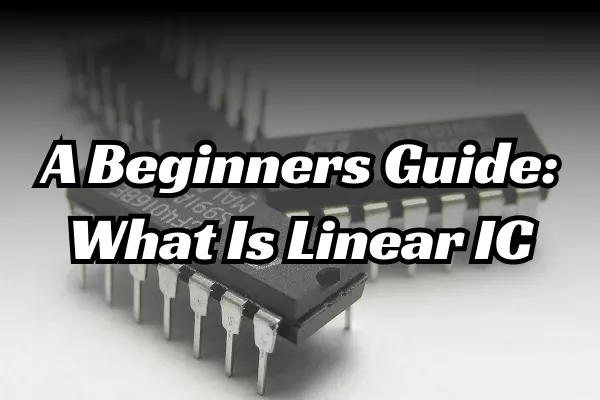In the context of the rapid development of modern science and technology, the application of linear integrated circuits not only exists widely in daily electronic products but also plays an indispensable role in scientific research and industrial fields. Therefore, a comprehensive understanding of linear integrated circuits is necessary.
This article will include three questions: what is meant by linear ic, how does it work, and what are its main types and practical applications in various fields?
It helps to understand the foundation of modern electronic technology and how it drives continuous innovation and progress in technology.

Detailed Answer: What Is Linear IC
Linear Integrated Circuits (ICs), commonly referred to as analog integrated circuits, are electronic devices that contain multiple analog functions in a single package or chip. These circuits are designed to process and manipulate continuous signals, such as audio, video, temperature, or voltage, as opposed to digital ICs that handle discrete signals like binary data.
Here are some key points about Linear ICs:
-
Analog Functions: Linear ICs are used to perform linear functions, such as amplification, filtering, modulation, demodulation, mixing, and more. They are particularly important in applications where signals need to be amplified, processed, or manipulated with a high degree of accuracy.
-
Signal Processing: Linear ICs are commonly used in signal processing applications where maintaining the integrity of the analog signal is critical. Examples include audio amplifiers, sensor interfacing circuits, voltage regulators, and data acquisition systems.
-
Operational Amplifiers (Op-Amps): One of the most common types of Linear ICs is the operational amplifier or op-amp. Op-amps are versatile integrated circuits that are widely used for various signal processing tasks, such as amplification, filtering, signal conditioning, and mathematical operations.
-
Precision and Accuracy: Linear ICs are designed to provide precise and accurate performance over a wide range of operating conditions. This makes them suitable for applications that require high accuracy, stability, and low noise levels in signal processing.
-
Applications: Linear ICs find applications in a wide range of fields, including audio and video equipment, telecommunications, instrumentation and measurement, control systems, power electronics, and sensor interfacing.
-
Types: Besides op-amps, other common types of linear ICs include voltage regulators, analog multipliers, analog switches, comparators, and analog-to-digital converters (ADCs). Each type of linear IC is designed to perform specific analog functions.
-
Advantages: Linear ICs offer advantages such as compact size, lower power consumption compared to discrete components, improved reliability due to fewer interconnections, and the ability to integrate multiple functions on a single chip.
In summary, Linear ICs play a crucial role in analog signal processing applications, providing precise and accurate performance for a variety of functions. Their versatility, reliability, and high-performance characteristics make them indispensable components in many electronic systems and devices.
What Are the Characteristics of A Linear IC
Linear Integrated Circuits (ICs) possess several key characteristics that differentiate them from digital integrated circuits. Here are some common characteristics of Linear ICs:
-
Analog Signal Processing: Linear ICs are designed to process continuous analog signals, such as audio, video, temperature, voltage, and other variable signals, as opposed to digital signals that have discrete values (0 or 1).
-
Linear Operation: Linear ICs are primarily designed to operate in a linear or continuous manner. This means that the output of the IC varies linearly with changes in the input signal. They are used in applications where the relationship between input and output signals needs to be linear and predictable.
-
Continuous Range of Values: Linear ICs can process signals that have a wide range of values, and their output varies proportionally with changes in the input signal across this continuous range.
-
Analog Components: Linear ICs are composed of analog components such as resistors, capacitors, transistors, and operational amplifiers. These components are interconnected within the IC to perform various analog signal processing functions.
-
High Precision and Accuracy: Linear ICs are designed to provide precise and accurate signal processing. They often offer high precision in parameters such as gain, frequency response, voltage regulation, and linearity.
-
Low Noise and Distortion: Linear ICs typically have low noise and distortion characteristics, which are crucial for maintaining signal integrity in analog applications. These characteristics help in preserving the quality of the processed signals.
-
Frequency Response: Linear ICs are designed to have a wide frequency response range, enabling them to process signals across a broad spectrum of frequencies without significant loss or distortion.
-
Amplification and Filtering: Linear ICs are commonly used for amplification, filtering, signal conditioning, modulation, demodulation, and other linear signal processing functions. They are essential in applications where signal amplification and manipulation are required.
-
Integrated Functionality: Many Linear ICs integrate multiple analog functions within a single chip, offering compact solutions that reduce the need for external components and interconnections. This integration enhances reliability and simplifies system design.
-
Versatility: Linear ICs are versatile components used in various applications, including audio equipment, communication systems, instrumentation, control systems, power supplies, and sensor interfaces, among others.
These characteristics highlight the importance of Linear ICs in analog signal processing applications where precision, accuracy, linearity, and reliable operation are crucial requirements.
The Applications of A Linear IC
Linear Integrated Circuits (ICs) find a wide range of applications in various industries due to their ability to process analog signals accurately and efficiently. Here are some common applications of Linear ICs:
-
Signal Conditioning:
- Linear ICs are extensively used for signal conditioning tasks such as amplification, filtering, and impedance matching in sensor interfaces and data acquisition systems.
-
Audio Amplification:
- Linear ICs, particularly operational amplifiers (op-amps), are integral components in audio amplifiers, preamplifiers, equalizers, and other audio processing equipment.
-
Control Systems:
- Linear ICs play a vital role in control systems by processing analog signals for feedback control, PID (Proportional-Integral-Derivative) control, motor control, and instrumentation circuits.
-
Instrumentation:
- Linear ICs are used in precision measurement and monitoring equipment, such as multimeters, oscilloscopes, temperature controllers, pressure sensors, and medical instruments.
-
Analog-to-Digital Conversion:
- Linear ICs are utilized in analog-to-digital converters (ADCs) to convert continuous analog signals into digital data for processing in digital systems.
-
Voltage Regulation:
- Linear voltage regulators ensure stable and regulated output voltages in power supplies, voltage references, and other applications requiring constant voltage levels.
-
Communications:
- Linear ICs are employed in communication systems for modulation, demodulation, amplification, and filtering of RF signals, such as in radio receivers and transmitters.
-
Waveform Generation:
- Linear ICs like function generators and waveform synthesizers are used to generate various waveforms for testing, calibration, and signal simulation purposes.
-
Audio Processing:
- Linear ICs are employed in audio processing modules for functions like tone control, audio mixing, audio equalization, and audio signal manipulation.
-
Sensor Interfaces:
- Linear ICs serve as interfaces between sensors and processing units, providing signal conditioning, amplification, and filtering to ensure accurate measurement and sensing.
-
Data Acquisition Systems:
- Linear ICs are crucial in data acquisition systems for converting analog signals from sensors or transducers into digital data for analysis and processing.
-
Industrial Automation:
- Linear ICs are utilized in industrial automation systems for functions like signal conditioning, motor control, process control, and analog interface circuits.
These applications demonstrate the versatility and importance of Linear ICs in enabling efficient and precise processing of analog signals across a wide range of industries and electronic systems.
Full List of 6 Linear Integrated Circuits in 2023
-
LM741 Op-Amp: The LM741 is a classic general-purpose operational amplifier known for its versatility and applications in amplification, signal conditioning, and more.
-
LM317 Voltage Regulator: The LM317 is a popular adjustable linear voltage regulator that provides stable and adjustable output voltage for various power supply applications.
-
NE5532 Dual Op-Amp: The NE5532 is a dual operational amplifier known for its low noise, high slew rate, and wide bandwidth, commonly used in audio applications and instrumentation.
-
LM324 Quad Op-Amp: The LM324 is a widely used quad operational amplifier that offers low power consumption and is suitable for applications requiring multiple op-amps in a single package.
-
LM386 Audio Amplifier: The LM386 is a low-voltage audio power amplifier IC used in audio circuits, portable devices, and low-power applications, providing amplification for audio signals.
-
LT1001 Precision Op-Amp: The LT1001 is a precision operational amplifier known for its high accuracy and stability, often used in precision instrumentation, sensor interfaces, and measurement equipment.
What Is the Distinction between Linear and Nonlinear IC
Linear Integrated Circuits (ICs) and Nonlinear Integrated Circuits differ primarily in how they process signals and perform functions. Here are the key distinctions between Linear and Nonlinear ICs:
Linear ICs:
-
Signal Processing:
- Linear Operation: Linear ICs process continuous analog signals in a linear manner where the output varies proportionally with changes in the input signal. This means that the relationship between input and output signals is linear and predictable.
-
Functionality:
- Analog Functions: Linear ICs are designed to perform linear functions such as amplification, filtering, signal conditioning, and voltage regulation. They are widely used in applications where maintaining signal accuracy and linearity is crucial.
-
Input-Output Relationship:
- Proportional Response: Linear ICs produce an output that is directly proportional to the input signal within their linear operating range. This makes them suitable for applications that require a linear response.
-
Examples:
- Operational Amplifiers (Op-Amps), voltage regulators, analog multipliers, and analog-to-digital converters are common types of Linear ICs that perform various linear signal processing functions.
Nonlinear ICs:
-
Signal Processing:
- Nonlinear Operation: Nonlinear ICs process signals in a nonlinear manner. The output signal does not vary directly with the input signal, and the relationship is often complex and nonlinear.
-
Functionality:
- Complex Operations: Nonlinear ICs can perform functions that involve nonlinear operations such as logic operations, signal modulation, frequency conversion, digital signal processing, and waveform generation.
-
Input-Output Relationship:
- Nonproportional Response: In Nonlinear ICs, the output signal may have complex dependencies on the input, leading to functions like switching, waveform shaping, frequency mixing, and other nonlinear processing.
-
Examples:
- Digital Signal Processors (DSPs), microcontrollers, logic gates, frequency synthesizers, and phase-locked loops are examples of Nonlinear ICs that perform complex operations on digital signals or use feedback mechanisms for control.
Summary:
Linear ICs are primarily used for linear signal processing applications where maintaining signal accuracy and linearity is critical. They process continuous analog signals with a direct and proportional relationship between input and output. On the other hand, Nonlinear ICs process signals in a nonlinear manner, often performing complex operations on digital signals, involving nonlinear relationships between input and output.
Understanding the distinctions between Linear and Nonlinear ICs is essential for selecting the right type of IC for a specific application based on the required signal processing characteristics and functionality.



